Boosting sky-blue light indoors reveals fundamental drivers of office productivity
Robert Soler and Kevin Long, BIOS Lighting, Carlsbad, CA 92011 | Published October 2025
Executive Summary
In only the past 5 years, science has converged and agreed that light has a strong influence on human mood, focus, and alertness. This finding is increasingly important, given that the average human spends more than 90% of their lives indoors. These responses from light are controlled via a dedicated sensor in our eye, responsive to blue wavelengths of light, which was only discovered in 2001. Now, we have a metric (m-EDI) for quantifying the effects and a criteria (m-EDI > 250 lux) for maximizing the benefits received by light. Unfortunately, standard classrooms, offices, and other daytime environments that were designed for only the visual aspects of light provide only about 25-50% of this criteria, compromising mood, focus, and alertness of millions of people. Simply increasing light levels will come at cost of comfort and energy expenditure, meaning it comes at the cost of deciding what’s good for the people versus what’s good for the planet.
BIOS has been at the forefront of wellness lighting for the past 15 years, since they developed the lighting for the international space station. They have focused on optimizing the wavelengths, color, intensity and distribution of light to drive the highest response to light, while maintaining optimal visual environment. This has resulted in the development of BIOS’ patented SkyView™ technology, which won a grant from the Department of Energy, to meet the wellness criteria without compromising comfort or energy.
This paper reviews 5 studies using SkyView™ technology, 3 included day-shift data and 2 included shift work data. The day-shift studies include clinical research as well as field research, while the shift-work research was conducted with the Department of Defense and an international airport. The results of these studies show the following effects of SkyView™ light on measures of mood, focus, alertness and performance:
Day Shift
- Up to 44% boost in mood
- 85% boost in focus
- 56% boost in Alertness
- 25% boost in self-reported productivity
Night Shift
- Up to 91% boost in mood
- 10% boost in focus
- 36% boost in alertness
- significant reduction in coffee consumed
- significant boost in sleep quality after shift.
Lighting Preference
- Over 88% of the study participants stated they would like to continue working under the enhanced lighting.
The results of these studies clearly show dramatic, reproducible improvements in key elements of office productivity and wellness, directly contributable to the boost in blue-sky spectra provided by SkyView™ lighting. These results support the incorporation of melanopic-rich SkyView™ lighting into office environments as a cost-effective, evidence-based strategy for improving employee well-being, cognitive performance, and overall productivity.
The role of lighting in promoting office productivity has evolved considerably.
Prior to 2022, lighting recommendations revolved around visual brightness and energy allowances. However, beyond its visual function, lighting modulates critical non-visual biological systems—particularly through sky-blue (melanopic) light, which targets photosensitive retinal ganglion cells (ipRGCs) that mediate physiological responses such as mood, focus and alertness, as well as synchronizing the body’s circadian rhythms (Vetter et al. 2022), demonstrating the importance of lighting beyond vision. In 2022, a consortium of international scientists came together to put in place a new metric for quantifying these physiological effects of light, as well as a minimum criteria for eliciting these effects of light (Brown et al. 2022). This new metric and circadian supportive criteria are now adopted by all governing authorities on light (i.e. IES, CIE, WELL, NASA, GSA).
It comes as no surprise that current design practices, which are solely based on the visual recommendations, fall way short of these new circadian supportive criteria. What is surprising, however, is how far off the criteria typical lighting applications are. Our analysis and case studies show that most typical applications in office and school settings provide less than half of this circadian supportive criteria, with some instances of as low as 25% of the criteria. However, further analysis shows that simply increasing brightness will come at the cost of increased glare and exceeding energy codes.
Office productivity depends significantly on employees’ mental states.

Mood

Focus

Alertness
Mood, focus, and alertness directly influence efficiency, quality of work, and decision-making capacity. The current WELL Building Standard includes circadian lighting design as part of its criteria, linking lighting quality to both wellness and performance in the modern workplace. In the 2025 IWBI Special Report summarizing the research behind the business case for healthy buildings and healthy organizations, they highlight a 12% boost in worker productivity due to implementing proper circadian focused lighting (Hartke et al. 2025). Equally important, the studies found 71% of participants reported feeling more energized, 76% felt happier and 50% felt healthier.
In this paper, we demonstrate the impact of advanced, economical commercially available high-melanopic lighting by experimentally manipulated office illumination spectra in field and clinical studies to measure the impact on mood, focus, and alertness.
Materials and Methods | Study Designs
The studies varied in length from 3 days to 7 weeks and consisted of a baseline period followed by alternating periods of standard LED lighting and high-melanopic light exposure. The 490nm enhanced (high-melanopic) spectrum was delivered using SkyView™ circadian lighting technology (Figure 1).
On average, the standard lighting conditions in the study and similar office environments provided about 32% of the recommended daytime melanopic light exposure of 250 lux m-EDI (MDER=0.67); whereas the SkyView™ illumination provided 136% of the threshold (MDER=1.1).
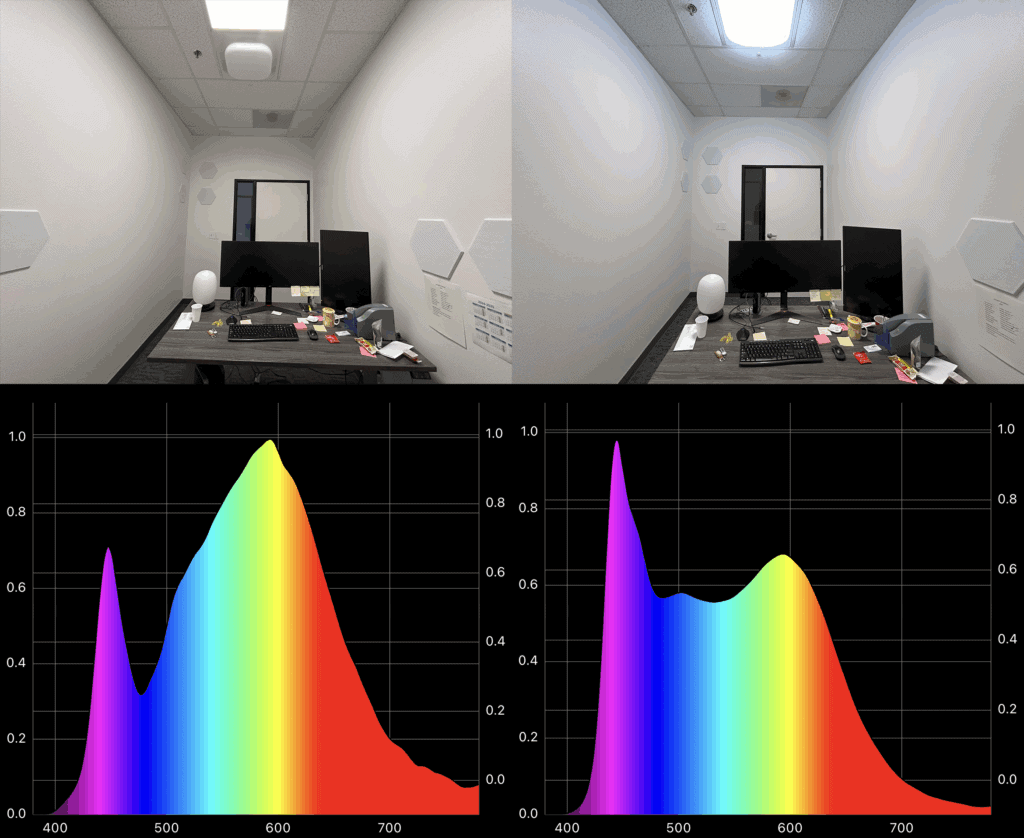
Figure 1. Interior office illuminated with standard LED (Top left panel; 103 lux – photopic; 64 lux – melanopic) or SkyView™ (Top right panel; 314 lux – photopic; 331 lux – melanopic) 2×2 troffer lighting. Spectral Power Distribution (SPD) measurements for the office under standard LED (Bottom left panel) or SkyView™ (Bottom right panel). Note the difference in power at 490nm.
Assessment Measures
Study participants were all adults and not subjected to prescreening. Lighting manipulations and assessments used in the studies were all conducted during daylight hours. Alertness, mood, and cognitive performance were assessed using standard psychometric measures and self-reporting surveys throughout the light exposure and compared between conditions (Table 1).

Table 1: Assessments used in the SkyView™ lighting intervention studies
Clinical Study
In a published Harvard-associated clinical study (Grant et al. 2023), 16 healthy young adults participated in a 2-day inpatient study with two 8-h simulated workdays and were randomized to either ambient fluorescent room light (~30 melanopic EDI lux, 50 lux), or room light supplemented with a SkyView™ desk lamp (~250 melanopic EDI lux, 210 lux) in a cross-over design. Alertness, mood, and cognitive performance were assessed throughout the light exposure and compared between conditions using linear mixed models.
Field Studies
Two field studies of similar design were conducted in office settings. The 5-week studies consisted of providing SkyView™ desk lamps to participants and setting alternating between standard and augmented office lighting while measuring performance aspects with periodic questionnaires (Figure 2). The first field study was conducted in several offices of a Fortune 500 global professional services company during normal business hours. The second field study was conducted in the 24-hour operations center at San Francisco International Airport (SFO).
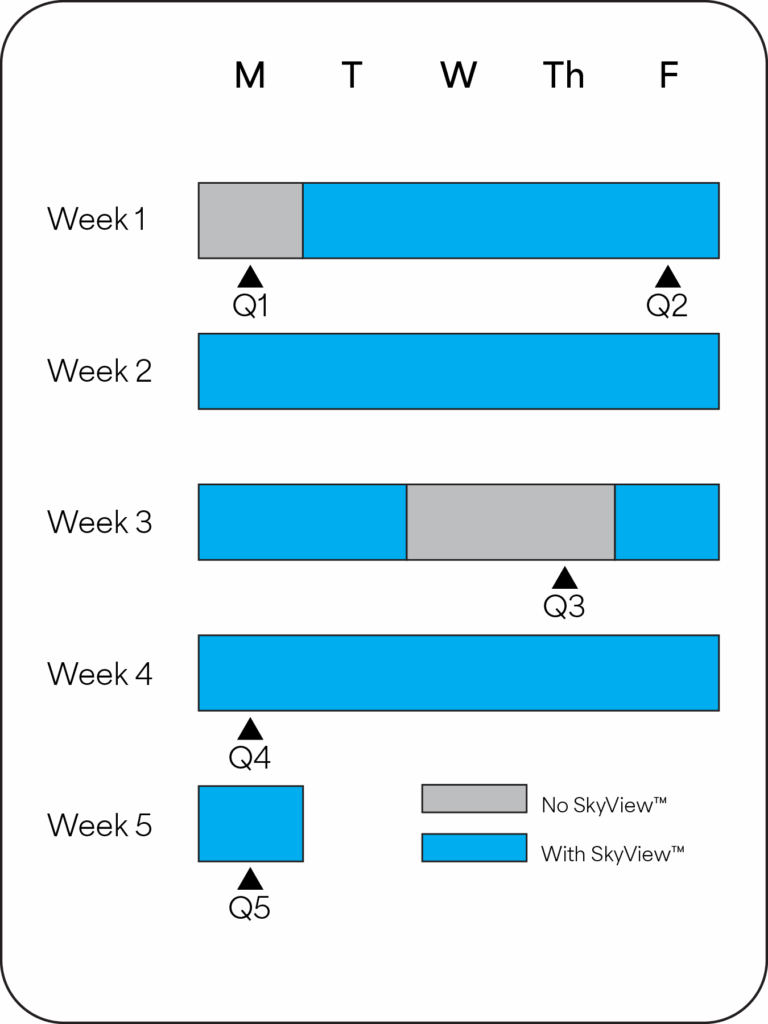
Figure 2. Office Lighting field study design. Baseline measurements were taken via online survey (Q1) with subsequent periodic surveys given as the lighting conditions were alternated over four weeks.
In a third field study focused strictly on 12-hour night shift work, the US Department of Defense (DoD) ran a study in an operations center using BIOS-designed high-melanopic lights (294 m-EDI) to measure mood, focus, alertness, and sleep effects (Figure 3; Bessman et al. 2023).
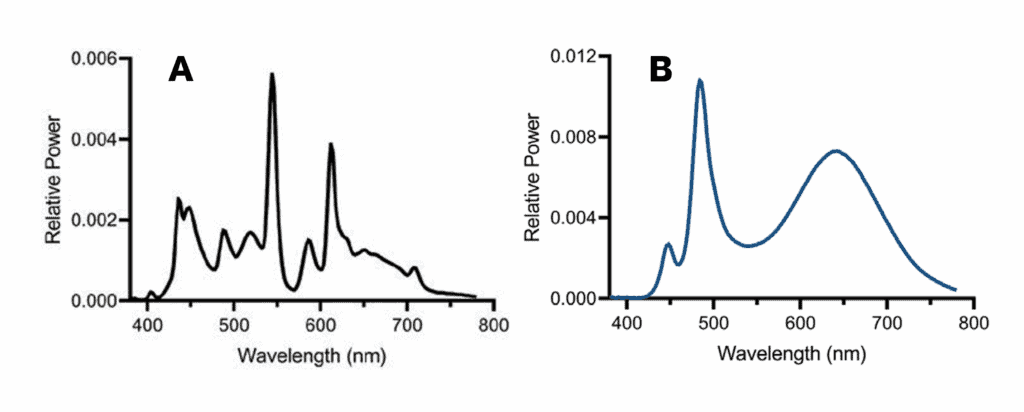
Figure 3. Spectral power distribution for lighting used in the Defense Department night shift work study. In this 16-day study, a battery of psychomotor and actigram and self-survey data was collected under standard (baseline) lighting (Panel A) and SkyView™ enhanced (Panel B).
Results | Mood Improvements
All three studies reported significant improvements in various measures related to ‘mood’. On average, in self-assessed measures the studies show SkyView™ light exposure resulted in a 44% increase in mood.
Clinical Study
The clinical study found that SkyView lighting significantly improved several measures of mood and well-being compared to standard ambient office lighting. Data from the KSS scores show that under SkyView™ supplemented office lighting participants reported relative to baseline:
Importantly, the supplemented light was not associated with any adverse visual experiences or discomfort, suggesting it provided measurable psychological and physiological benefits without negative side effects.
Field Studies
In both field studies, the improved lighting correlated with increased mood and other measures (Figures 4 & 5). Removal of the SkyView™ light mid study showed a decline in most wellness and performance measures. Subsequent return of the light in weeks 4 and 5 showed a dramatic increase in response higher than the initial responses of the first week. Total change from baseline in the F500 company study showed a 33% increase in mood measures (Figure 4). Total change from baseline in the SFO Operations room study showed a 17% increase in mood measures (Figure 5).
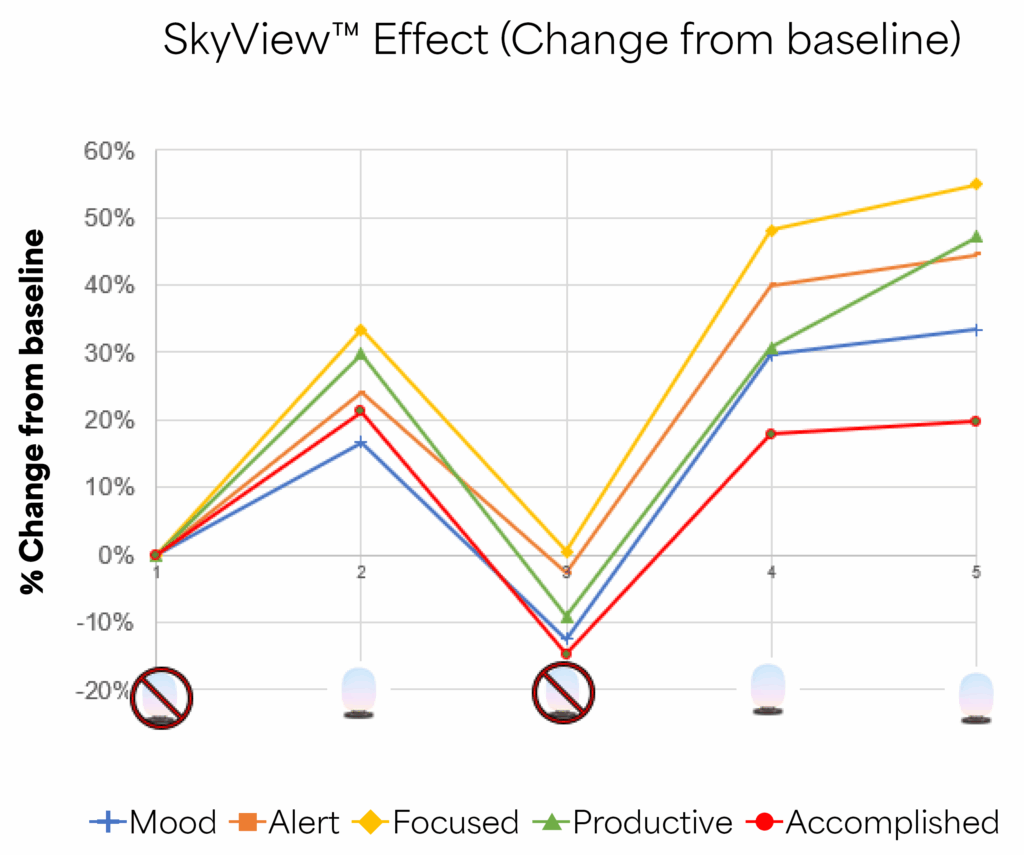
Figure 4. Results from the F500 Company intervention study. Mood and performance measures were compared between standard (baseline) office lighting and SkyView™ lamp supplemented lighting. Change in values were plotted over the 5-week study.
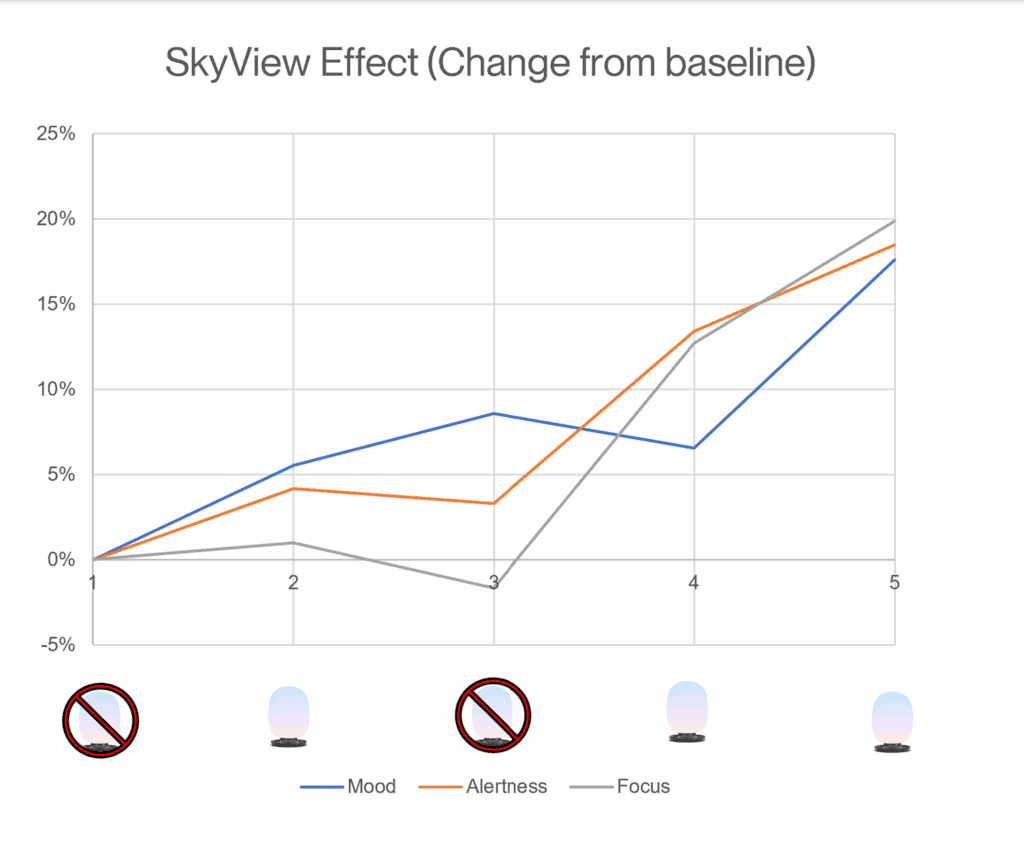
Figure 5. Results from the SFO Operations Center intervention study. Mood and performance measures were compared between standard (baseline) office lighting and SkyView™ lamp supplemented lighting. Change in values were plotted over the 5-week study.
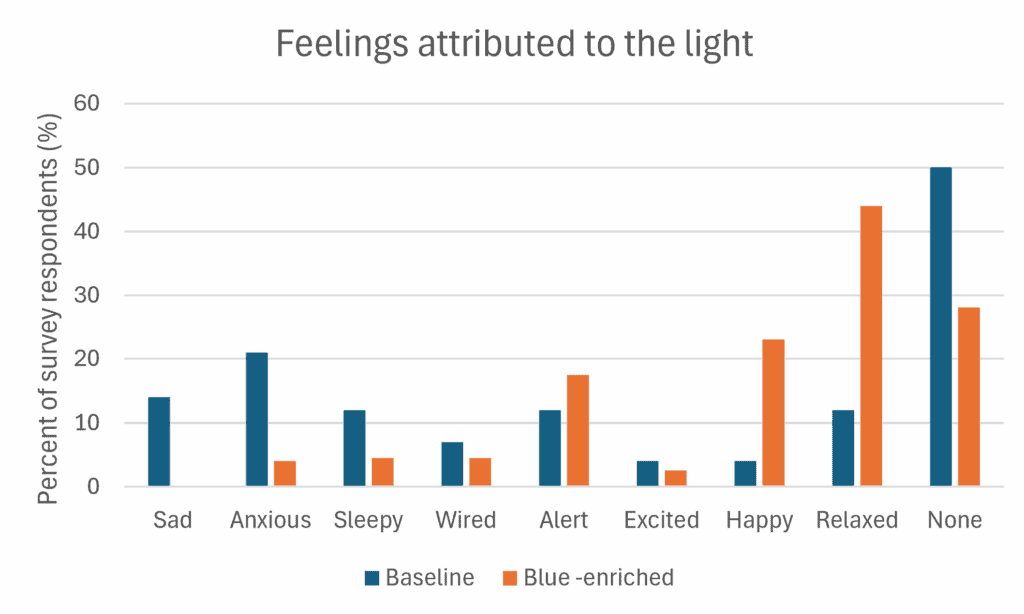
Figure 6. Self-reported survey results from the DoD night shift study. Different components of mood were measured under both standard (baseline) and high-melanopic lighting. Graph adapted from Bessman et al. 2023.
Night Shift Studies
Both the SFO and DoD studies included night shift workers. Overall, measures of positive mood were significantly improved under high-melanopic light with a 91% boost over standard lighting. In the DoD study, both positive and negative mood attributes were measured under both lighting conditions (Figure 6). The blue-enriched light reduced unproductive feelings (sad, anxious, sleepy) by an average of 81%. In contrast, positive attributes that could promote productivity (wired, alert, excited, happy, relaxed) were increased by 143% under the blue-enriched lights.
Results | Focus Improvements
All three studies reported significant improvements in various measures related to office occupants’ ability to focus on tasks. On average, in objective and self-assessed measures the studies show SkyView™ light exposure resulted in an 85% increase in task focus.
Clinical Study
The clinical study found that SkyView lighting significantly improved several measures of task focus compared to standard ambient office lighting. Data from cognitive and PVT reaction time tasks show that under SkyView™ supplemented office lighting participants reported relative to baseline:
Field Studies
In both field studies, the improved lighting correlated with increased ability to focus on tasks (Figures 4 & 5). Removal of the SkyView™ light mid study showed a steep decline in focus and performance measures. Subsequent return of the light in weeks 4 and 5 showed a dramatic increase in response higher than the initial responses of the first week. Total change from baseline in the F500 company study showed a 55% increase in focus measures (Figure 4). Total change from baseline in the SFO Operations room study showed a 20% increase in focus measures (Figure 5).
Night Shift Studies
Self-survey measures of feeling focused were improved by 10% under blue-enriched SkyView™ light but psychomotor vigilance task (PVT) data as a measure of focus showed no significant increase (DoD study).
Results | Alertness Improvements
All three studies reported significant improvements in measures related to occupant alertness versus drowsiness. On average, in self-assessed measures the studies show SkyView™ light exposure resulted in a 56% improvement in alertness.
Clinical Study
The clinical study found that SkyView™ lighting significantly improved several measures of occupant alertness compared to standard ambient office lighting. These improvements came with correspondingly decreased sleepy, tired, or physically exhausted feelings. KSS and other survey results show that under SkyView™ supplemented office lighting participants reported relative to baseline:
Field Studies
In both field studies, the improved lighting correlated with increased alertness (Figures 4 & 5). Removal of the SkyView™ light mid study showed a sharp decline in alertness. Subsequent return of the light in showed a dramatic increase in response higher than the initial responses of the first week. Total change from baseline in the F500 company study showed a 44% increase in alertness measures (Figure 4). Total change from baseline in the SFO Operations room study showed a 18% increase in alertness (Figure 5).
Night Shift Studies
Night workers reported a 36% increase in measures of alertness over their shifts under blue-enriched lighting. In addition, they reported a 68% reduction in sleepiness (Figure 6) and 7% improvement in sleep quality as measured by survey and actigraphy (Bessman et al. 2023). The study subjects also reported a 16% reduction in the need for caffeine with the enhanced lighting.
Results | Feelings of Productivity
In addition to mood, focus, and alertness measures, the clinical and field studies also measured more subjective aspects of productivity like motivation and feelings of productivity and accomplishment. Exposure to SkyView™ light positively impacted these:
In the DoD study, light comfort measures (glare, headache, nausea, fatigue) were also recorded. These are well known factors that can interfere with productivity. These measures were all improved by an average of 87% under the enhanced lighting.
Discussion
Study participants overwhelming preferred the SkyView™ enhanced lighting for their work environments (88%). The results from the clinical and field studies strongly suggest that melanopic-rich lighting, such as BIOS SkyView™, provides substantial benefits for mood, focus, and alertness, key factors driving office productivity. Unlike standard office lighting, which is typically deficient in the short-wavelength “blue sky” portion of the spectrum, melanopic-enriched light directly engages the intrinsically photosensitive retinal ganglion cells (ipRGCs) in the eye. These cells regulate circadian rhythms and influence neurobiological pathways tied to mood, alertness, and cognitive performance (Berson et al. 2002; Lucas et al. 2014). The consistent improvements across both controlled and real-world environments highlight the importance of incorporating biologically meaningful light into workplace design.
Mood and Well-Being Under SkyView™ Light
One of the most striking findings is the significant improvement in mood measures under SkyView™ light. Self-reported happiness, motivation, and feelings of health improved dramatically in the clinical study, with increases up to 359% (Healthy-Sick measure). The effects of boosted sky-blue light on night shift workers were even more pronounced than day workers, which is even more significant given known psychophysiological challenges with shift work (Brown et al. 2020). Similarly, in field studies, participants consistently reported elevated mood during periods of enriched lighting, followed by sharp declines when the lighting was removed, and rapid rebounds upon reintroduction. These patterns strongly suggest a causal role of melanopic-rich light in sustaining positive affect. Prior research supports these findings: exposure to blue-enriched white light has been shown to reduce depressive symptoms, enhance positive affect, and improve overall psychological well-being (Viola et al. 2008; Vandewalle et al. 2010; Cajochen et al. 2019). Elevated mood is more than just a wellness outcome—it directly influences collaboration, creativity, and overall office morale, all of which contribute to organizational productivity.
Focus and Cognitive Performance Under SkyView™ Light
The results also demonstrate a clear link between melanopic-rich lighting and cognitive functioning. Improvements in reaction time, attentional stability, and task accuracy were consistently higher under SkyView™ lighting. The clinical study showed significant and dramatic improvements in task accuracy and reduction of attentional failures, pointing to profound benefits for sustained attention in demanding work environments. Laboratory evidence reinforces these findings: blue-enriched light enhances cognitive performance, shortens reaction times, and strengthens executive functioning by modulating brain activity in regions responsible for attention and working memory (Cajochen et al. 2005; Lockley et al. 2006). Field data showing declines in focus coinciding with the removal of SkyView™ lighting and rebounds with its return further underscore the role of circadian-effective light in mitigating mental fatigue and enhancing task performance.
Alertness and Energy Under SkyView™ Light
The introduction of SkyView™ lighting also significantly improved measures of alertness. Participants reported being more awake, energetic, and less fatigued, with corresponding decreases in feelings of tiredness and exhaustion. These findings align with controlled trials showing that blue-enriched light reduces subjective sleepiness and increases daytime alertness, even in populations experiencing fatigue or shift work (West et al. 2019; Bessman et al. 2023). Circadian-informed lighting, with blue-enriched daytime and blue-depleted evening illumination can substantially mitigate sleep, performance, and health effects related to misaligned day/night schedules (Guyett et al. 2024). In modern offices, where long work hours, extended screen exposure, and minimal daylight are common, circadian-effective light is critical to sustaining optimal alertness (Figueiro et al. 2019). Enhanced wakefulness not only improves moment-to-moment productivity but also reduces cognitive errors and improves workplace safety. The added alertness support attributed by the lights was particularly appreciated by the night shift workers in the San Francisco International Airport operations room (SFO study) and the high-security night-watchfloor (DoD study). Study subjects in those environments reported that mistakes in their duties can have very serious consequences.

Implications for Workplace Productivity
Beyond specific measures of mood, focus, and alertness, participants also reported improvements in motivation, accomplishment, and overall feelings of productivity. These findings are critical because they show that the benefits of melanopic-rich light extend beyond measurable cognitive tasks to broader workplace outcomes. (Mills et al. 2007; Belany et al. 2024; Charkhabi et al. 2025). Employees not only performed better but also felt more productive, which likely contributes to job satisfaction, organizational commitment, and reduced turnover. Interestingly, the night-shift DoD workers also took quality of life (QOL) surveys covering health, socioeconomic, psychological/spiritual, family, and performance factors (Bessman et al. 2023) and reported statistically significant improvements across almost all categories under the enhanced lighting. Given that workplace productivity is heavily influenced by physiological and psychosocial factors just as much as organizational and operational ones, circadian-effective lighting should be considered an essential part of office design, not a “nice to have”.
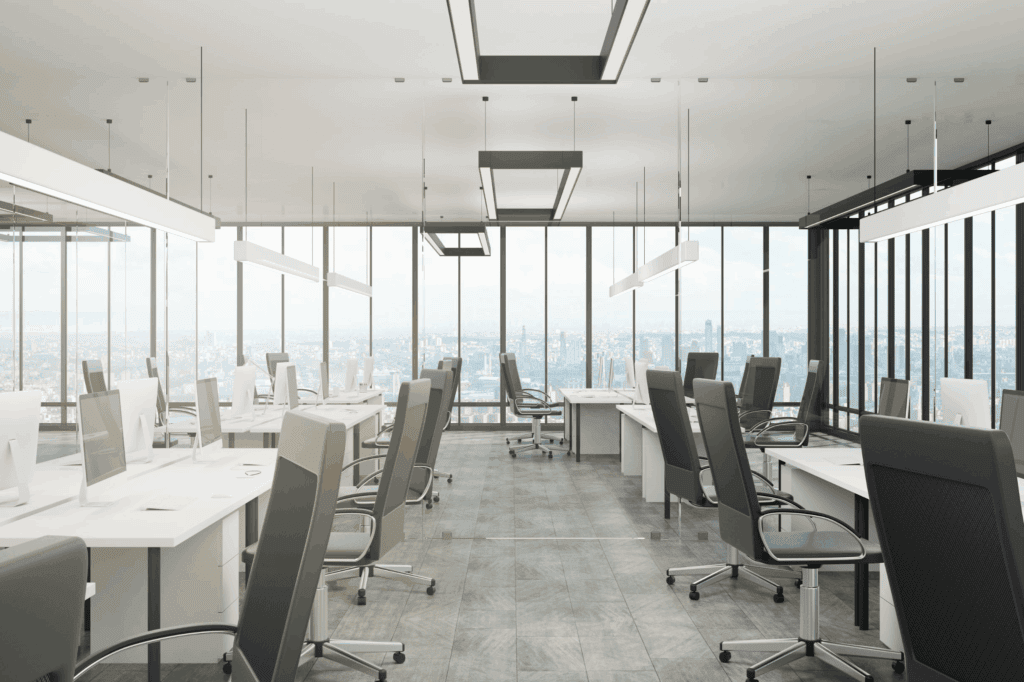
The Challenge of Bringing High-Melanopic Light into the Office
Taken together, these findings highlight the inadequacy of conventional office lighting, which prioritizes visual comfort but neglects circadian and biological needs. The need for higher melanopic exposure indoors has reached consensus in the medical/scientific (Brown et al. 2022) and architectural lighting worlds (ANSI/IES RP-46-23). However, providing high-melanopic light via daylighting, color tuning, or boosting intensity of traditional lighting systems does not seem to be effective, because of reported heterogeneous exposure, harsh color temperatures, glare, or excessive power consumption (Safranek et al. 2023; Gagne et al. 2024; Ticleanu et al. 2025).
Achieving threshold levels of melanopic light using windows can be challenging (Ticleanu et al. 2025). Melanopic light penetration is particularly sensitive to window and viewer orientation, latitude, seasons, and weather. The reduction in melanopic light might be further affected by window transmission factors like tint, shades, visual obstructions, etc.) and colored surface reflectance. One would think that this is where interior lighting comes in; however, the resulting melanopic light deficit in most interior areas is not easily rescued using standard electric lighting or computer monitors. Looking around the middle of a cubical filled office, a view outside to blue sky seems far. The result is inadequate melanopic exposure that impacts health and wellbeing (Burns et al. 2022; Windred et al. 2024).
Bringing the Health and Performance Benefits of a Blue-Sky Day Indoors
By contrast, SkyView™ lighting, with it’s patented color separation technology (GCO™ ), provides comfortable, naturalistic light at the targeted 250 m-EDI. The SkyView™ studies demonstrate that spectral shifts aligned with human circadian biology can produce measurable, meaningful improvements in mood, focus, and alertness. Incorporating melanopic-rich SkyView™ lighting (Figure 7) into office environments represents a cost-effective, evidence-based strategy for improving employee well-being, cognitive performance, and overall productivity.
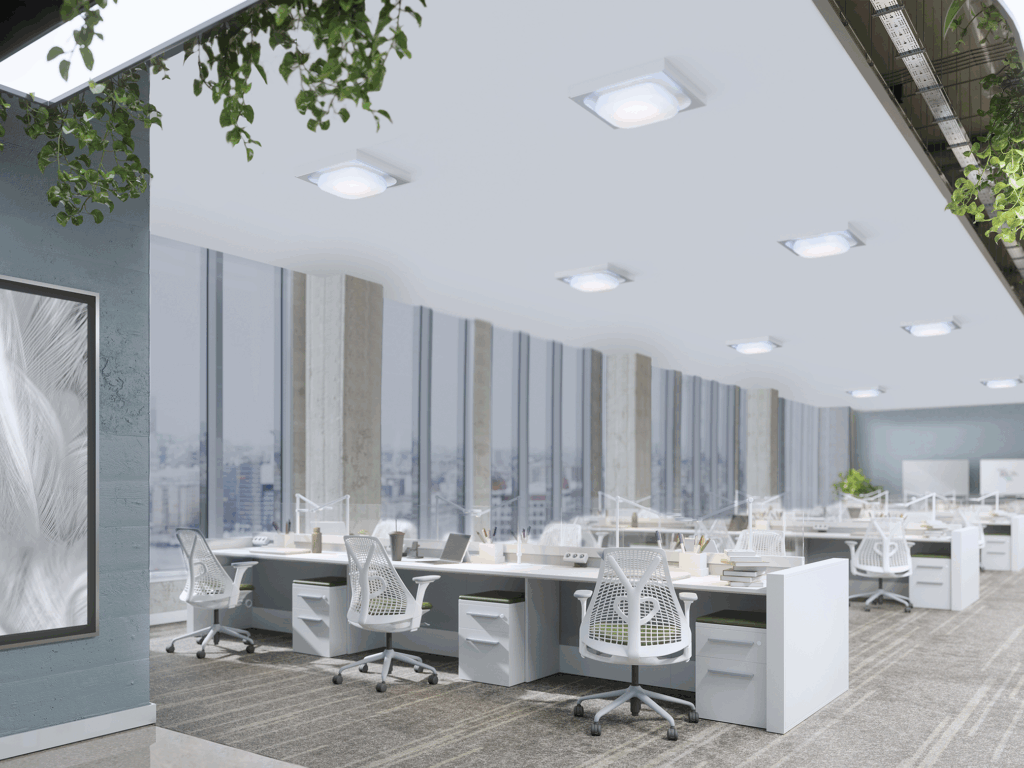
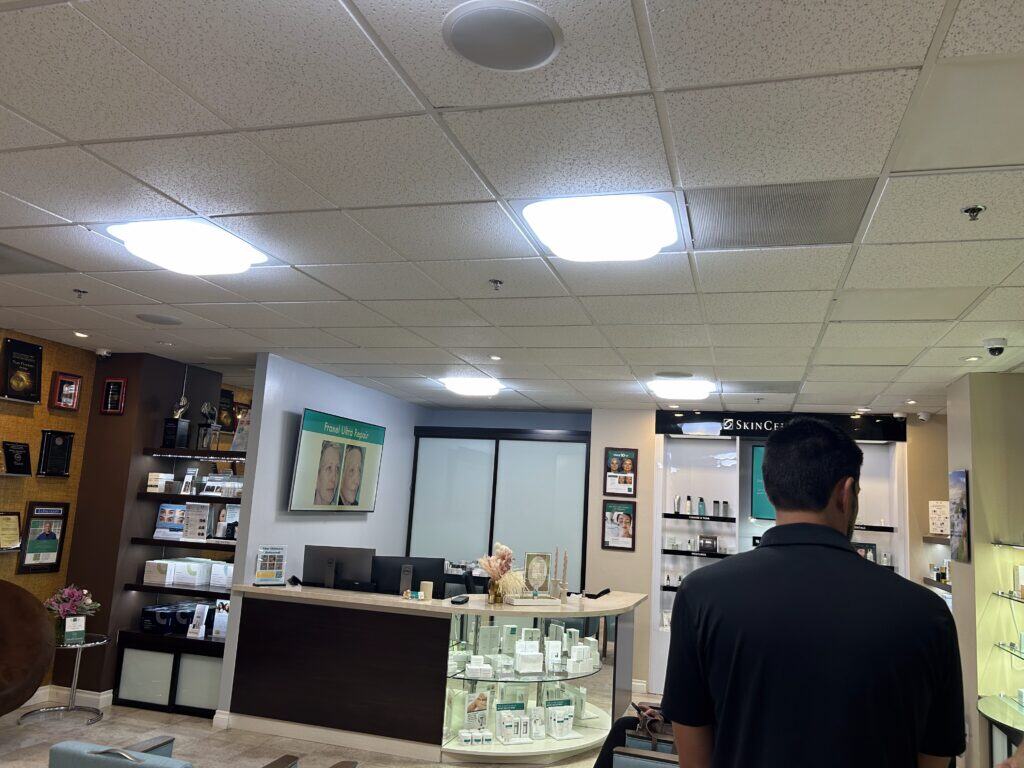
Figure 7. SkyView™ Tile in simulated office environment (left panel) and medical office (right panel)
References
Belany P, Hrabovsky P, Florkova Z, Cajova Kantova N. The impact of workplace lighting on employee well-being and productivity: a measurement study. System Safety: Human-Technical Facility-Environment. 2024;6.
Berson DM, Dunn FA, Takao M. Phototransduction by retinal ganglion cells that set the circadian clock. Science. 2002 Feb 8;295(5557):1070-3.
Bessman SC, Harrison EM, Easterling AP, Snider MN, Preilipper SM, Glickman GL. Hybrid effectiveness-implementation study of two novel spectrally engineered lighting interventions for shiftworkers on a high-security watchfloor. Sleep Advances. 2023 Jan 1;4(1):zpad051.
BIOS. Business at the speed of circadian light. 2023. https://bioslighting-skyview.com/circadian-lighting-productivity-study/
Brown JP, Martin D, Nagaria Z, Verceles AC, Jobe SL, Wickwire EM. Mental health consequences of shift work: an updated review. Current psychiatry reports. 2020 Feb;22(2):7.
Brown TM, Brainard GC, Cajochen C, Czeisler CA, Hanifin JP, Lockley SW, Lucas RJ, Münch M, O’Hagan JB, Peirson SN, Price LL. Recommendations for daytime, evening, and nighttime indoor light exposure to best support physiology, sleep, and wakefulness in healthy adults. PLoS biology. 2022 Mar 17;20(3):e3001571.
Burns AC, Windred DP, Rutter MK, Olivier P, Vetter C, Saxena R, Lane JM, Phillips AJ, Cain SW. Low daytime light and bright night-time light are associated with psychiatric disorders: an objective light study in> 85,000 UK Biobank participants. medRxiv. 2022 Oct 17:2022-10.
Cajochen C, Munch M, Kobialka S, Krauchi K, Steiner R, Oelhafen P, Orgul S, Wirz-Justice A. High sensitivity of human melatonin, alertness, thermoregulation, and heart rate to short wavelength light. The journal of clinical endocrinology & metabolism. 2005 Mar 1;90(3):1311-6.
Cajochen C, Freyburger M, Basishvili T, Garbazza C, Rudzik F, Renz C, Kobayashi K, Shirakawa Y, Stefani O, Weibel JJ. Effect of daylight LED on visual comfort, melatonin, mood, waking performance and sleep. Lighting Research & Technology. 2019 Nov;51(7):1044-62.
Charkhabi SA, Sharifi Z, Janizadeh R, Rahdar M, Kazemi R. The effect of blue light on cognitive function at workplaces: A systematic review. Physiology & Behavior. 2025 Feb 1;289:114758.
Figueiro MG, Kalsher M, Steverson BC, Heerwagen J, Kampschroer K, Rea MS. Circadian-effective light and its impact on alertness in office workers. Lighting Research & Technology. 2019 Apr;51(2):171-83.
Grant LK, Crosthwaite PC, Mayer MD, Wang W, Stickgold R, St. Hilaire MA, Lockley SW, Rahman SA. Supplementation of ambient lighting with a task lamp improves daytime alertness and cognitive performance in sleep-restricted individuals. Sleep. 2023 Aug 1;46(8):zsad096.
Guyett A, Lovato N, Manners J, Stuart N, Toson B, Lechat B, Lack L, Micic G, Banks S, Dorrian J, Kemps E. A circadian-informed lighting intervention accelerates circadian adjustment to a night work schedule in a submarine lighting environment. Sleep. 2024 Nov;47(11):zsae146.
Hartke J, Worden K, Yang M, Gray W A. Investing in Health Pays Back, 2nd Edition: The business case for healthy buildings and healthy organizations. International WELL Building Institute. 2025 www.wellcertified.com/health-pays-back/second-edition.
Illuminating Engineering Society. ANSI/IES RP-46-23, Recommended Practice: Supporting the Physiological and Behavioral Effects of Lighting in Interior Daytime Environments. New York: IES; 2023.
Lockley SW, Evans EE, Scheer FA, Brainard GC, Czeisler CA, Aeschbach D. Short-wavelength sensitivity for the direct effects of light on alertness, vigilance, and the waking electroencephalogram in humans. Sleep. 2006 Feb 1;29(2):161-8.
Lucas RJ, Peirson SN, Berson DM, Brown TM, Cooper HM, Czeisler CA, Figueiro MG, Gamlin PD, Lockley SW, O’Hagan JB, Price LL. Measuring and using light in the melanopsin age. Trends in neurosciences. 2014 Jan 1;37(1):1-9.
Mills PR, Tomkins SC, Schlangen LJ. The effect of high correlated colour temperature office lighting on employee wellbeing and work performance. Journal of circadian rhythms. 2007 Jan 11;5(1):2.
Safranek S, Collier J, Baker J, Jacobsen J, Wilkerson A. Lighting for Health and Wellness Recommendations in Offices: A Circadian Lighting Pilot Project in Chicago, IL. Pacific Northwest National Laboratory (PNNL), Richland, WA (United States); Schuler Shook, Chicago, IL (United States); 2023 Jan 1.
Ticleanu C, Flores-Villa L, Littlefair P, Howlett G. Assessing melanopic equivalent daylight illuminance in office spaces using a simplified approach for predominantly cloudy climates. Lighting Research & Technology. 2025 Feb 24:14771535251317740.
Vandewalle G, Maquet P, Dijk DJ. Light as a modulator of cognitive brain function. Trends in cognitive sciences. 2009 Oct 1;13(10):429-38.
Vetter C, Pattison PM, Houser K, Herf M, Phillips AJ, Wright KP, Skene DJ, Brainard GC, Boivin DB, Glickman G. A review of human physiological responses to light: implications for the development of integrative lighting solutions. Leukos. 2022 Jul 3;18(3):387-414.
Viola AU, James LM, Schlangen LJ, Dijk DJ. Blue-enriched white light in the workplace improves self-reported alertness, performance and sleep quality. Scandinavian journal of work, environment & health. 2008 Aug 1:297-306.
West A, Simonsen SA, Jennum P, et al. An exploratory investigation of the effect of naturalistic light on fatigue and subjective sleep quality in stroke patients admitted for rehabilitation: A randomized controlled trial. NeuroRehabilitation. 2019;45(2):187-200. doi:10.3233/NRE-192752
Windred DP, Burns AC, Lane JM, Olivier P, Rutter MK, Saxena R, Phillips AJ, Cain SW. Brighter nights and darker days predict higher mortality risk: A prospective analysis of personal light exposure in> 88,000 individuals. Proceedings of the National Academy of Sciences. 2024 Oct 22;121(43):e2405924121.
